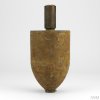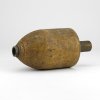The lance bomb was designed by Marten Hale - of No.3 rifle grenade, and 10lb and 20lb aerial bomb, fame. His Cotton Powder Company received an order for 1,000 of the 7-pr Harpoon bombs in February 1915, at £4 each (contract value £4,000).
It was introduced in WOLC paragraph 17379 of March 1915; "The bomb consists of a steel plate body with an ogival head... The wood stave is 39 inches long... The bomb is painted yellow, and has a red ring painted round the head, and a green band round the body, the former denoting that it is filled and the latter the explosive used. The bombs and detonators are issued separately, four of each being packed in a wood box. The staves are issued in bundles of ten."
It was issued to Royal Navy Reserve drifters for harpooning of U-boats caught in their barrage nets. Robert George Hurren, RNR, skipper of the Lowestoft-based drifter "Gleaner of the Sea" was awarded the DSC in July 1916 for "Distinguished conduct which led to destruction of an enemy submarine boat" - he used lance bombs to damage either the UB13 or UC1.
The attached image is of Marten Hale demonstrating the ease with which his harpoon bomb could be deployed...









